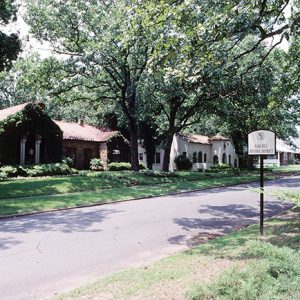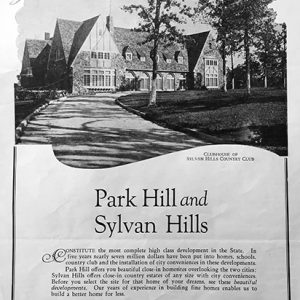calsfoundation@cals.org
Park Hill Historic District
The Park Hill Historic District in North Little Rock (Pulaski County) recognizes the city’s first planned suburban development and its growth. Listed on the National Register of Historic Places in 2000, following a survey by historian Sandra Taylor Smith, the district includes 568 properties from two distinct periods of development: 1920s Craftsman bungalows and Period Revival styles, and 1940s Minimal Traditional styles. The historic designation is strictly honorary, not being subject to regulations regarding architectural change.
In 1921, businessman Justin Matthews Sr. acquired significant acreage in the sparsely populated, wooded “high country” north of the North Little Rock city limits. With the Broadway Bridge under construction and the time being ripe for development, Matthews announced the debut of Park Hill in 1922. He advertised the community as a “second Pulaski Heights” but with higher elevation, better views, cooler temperatures, and health benefits. Unlike Pulaski Heights (Pulaski County), which was well-paved and accessible by streetcar, Park Hill was remote and lacking in streets. With the growing popularity of automobiles, Matthews set about improving roadways in and around Park Hill.
To jumpstart the development, Matthews’s Park Hill Land Company financed home sales with ten percent down andpay outs for construction coststhat ranged from $3,000 to $7,000. Lots of two and a half, five, and ten acres at $50 each were offered as miniature country estates. The Arkansas Gazette reported on April 30, 1922, that “streets are being laid out and arc lights are to be installed. Yesterday workmen were digging holes for street light poles and in a few weeks Park Hill will have all the modern conveniences of a regular suburb.” Electric lines were installed, a new bus line was in service, and work began on a water system in 1923. Matthews built Park Hill Elementary School, which opened in 1925 after he donated it to the North Little Rock School District. Matthews sat as commissioner on improvement districts for the Broadway and Main Street bridges and North Little Rock’s Main Street viaduct, which facilitated traffic northward to Park Hill. Matthews also served on Arkansas’s first Highway Commission and oversaw the paving of the Arkansas-Missouri Highway (Highway 107), which ran through Park Hill.
Matthews employed about 200 people, including an architect, brick mason, road engineer, and landscaper. Craftsman architecture, nationally popular in the 1920s, is predominate in Park Hill. Also found are English Revival cottages with steep gabled roofs, gabled porches, and tapered chimneys. Spanish Revival styles feature stucco walls, flat roofs, terraces, patios, and decorative ceramic tiles. More than 200 homes had been built by 1927 when Matthews launched a high-end development known as Edgemont in Park Hill. Listed on the National Register in 1992, Edgemont includes eleven grand-scale homes built from 1927 to 1931.
While the Great Depression halted most Park Hill housing constructionuntil the 1940s, public projects forged ahead. Construction of the Park Hill Fire Station and Water Company buildings at a cost of $8,000 in 1938 was a joint effort by Park Hill and the Works Progress Administration (WPA). Designed by the Brueggeman, Swaim and Allen architectural firm of Little Rock (Pulaski County), these two Mediterranean-style buildings feature red tile roofs, arched windows, and decorative cast concrete detailing. Located in the 3400 block of Magnolia Street, the complex was listed on the National Register in 1993. A theater, pharmacy, grocery, and post office were among the first tenants in a community shopping center that opened in 1941 in the 3400 block of the Arkansas-Missouri Highway (renamed John F. Kennedy Boulevard in 1963). Although Park Hill had a fire department in 1939, the unincorporated subdivision had no fire truck or equipment until 1944—two years before its annexation to North Little Rock. Its water company, managed by Edward A. McCain, merged with North Little Rock’s in 1959.
Among the original covenants in Park Hill was a restriction that prohibited African Americans from buying property in the subdivision. But civil rights legislation in the 1960s and subsequent federal court rulings outlawed such discrimination in housing.
More than 100 homes were built in Park Hill in the early 1940s with the influx of soldiers to Camp Joseph T. Robinson during World War II. Demand intensified with the return of veterans and readily available, government-backed loans. Small, affordable homes were popular, including eighty-four prefabricated houses manufactured and moved on site by Bralei Homes, Inc. Street widening and commercial development on John F. Kennedy Boulevard in the 1960s razed historic houses and replaced them with fast food restaurants. Subsequently, Park Hill residents and business owners have explored ways to boost economic vitality and promote the area’s historic appeal. A federal grant awarded to the North Little Rock History Commission in 2010 supported a branding and marketing campaign for the benefit of historic Park Hill.
For additional information:
Bradburn, Cary. On the Opposite Shore: The Making of North Little Rock: North Little Rock History Commission, 2004.
“Park Hill Historic District.” National Register of Historic Places nomination form. On file at Arkansas Historic Preservation Program, Little Rock, Arkansas. Online at http://www.arkansaspreservation.com/National-Register-Listings/PDF/PU9753.nr.pdf (accessed October 19, 2021).
Smith, Sandra Taylor. The Park Hill Historic District, North Little Rock. Little Rock: Arkansas Historic Preservation Program, 2000.
Cary Bradburn
North Little Rock History Commission
 Early Twentieth Century, 1901 through 1940
Early Twentieth Century, 1901 through 1940 Historic Preservation
Historic Preservation Park Hill Historic District
Park Hill Historic District  Park Hill Historic District
Park Hill Historic District  Sylvan Hills Country Club Ad
Sylvan Hills Country Club Ad 




Comments
No comments on this entry yet.